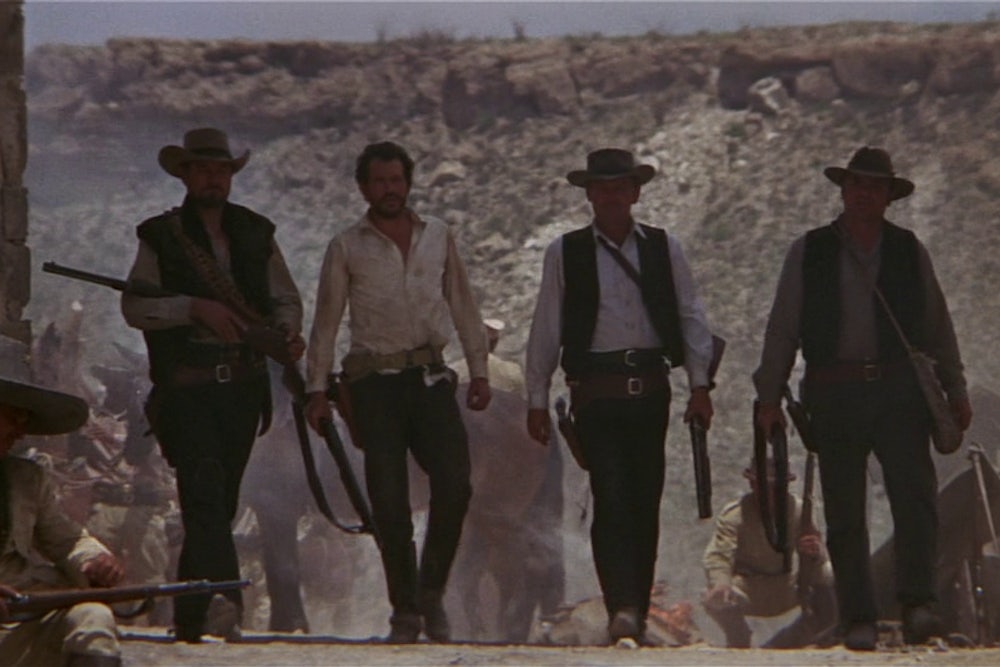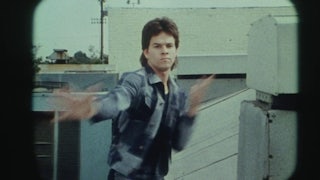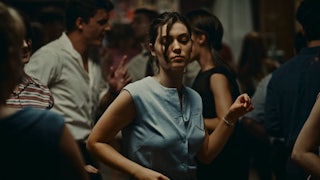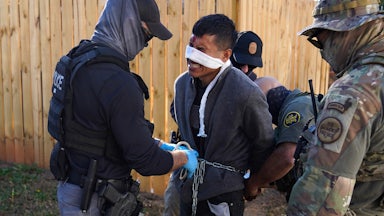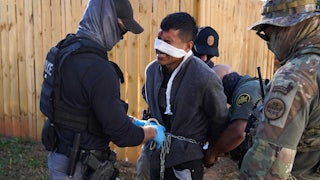The Western, until quite recently, was especially valuable as a mythic preserve: a form in which Good and Evil could be easily identified and in which Good could triumph. Lately it is becoming an arena for exultation in gore with perhaps a fade-out nod to virtue—a Theater of Cruelty on the cheap. The Italian-made Westerns have done it in an almost childish way: their gore is so patently contrived that the shock is merely annoying, like a boy’s thrusting a dead mouse in your face and cackling at your disgust. The well-made American Western is more effective, more lopsidedly truthful.
The Bad Man as protagonist is an old idea in Westerns, but he was always Wallace Beery in one form or another, a lovable bandit who reformed or gave his life gladly at the end in expiation. Now we get killers as heroes, and everything we learn about them is intended to make them acceptable as killers, not to explain how they went astray and might have been good ranchers or bank tellers if fate had been kinder.
In the hands of Sam Peckinpah, the matter becomes more complex because he is such a gifted director that I don’t see how one can avoid using the word “beautiful” about his work. This is not merely a matter of big vistas and stirring gallops and silhouettes against the sky, although Peckinpah understands all about them. It is a matter of the kinetic beauty in the very violence that his film lives and revels in. Peckinpah has been quoted as saying that he included so many horrors in order to make us sick of violence. Well, people will say almost anything in interviews, and it is the tale that must be trusted, not the teller. He is not an oblique puritan, he is a talented maniac who loves his bloody work. And the work is significant.
I missed Peckinpah’s Ride the High Country (1961), which was reliably praised, and have been trying to catch up with it. I saw Major Dundee (1965), about which Peckinpah is said to be unhappy because of interference but which was distinguished by some gritty fighting, some smacking physical detail, and Charlton Heston’s most credible performance. The Wild Bunch, Peckinpah’s latest, runs two hours and forty-five minutes, was written by Peckinpah and Walon Green, and was photographed in Technicolor and Panavision by Lucien Ballard, who was a protegé of von Sternberg and whose distinguished career includes some precious Westerns. This new film is the best Western I can remember since Brando’s One-eyed Jacks (1960).
The time is around 1913, the place is both sides of the Texas-Mexican border. The contrast between the US and Mexican cultures is important to Peckinpah (as it was to brando). It’s a handy way to juxtapose Europe and America, to show the pretenses and practices of both, which, under differing delusions and nouns, end up fairly concentrically. The “bunch” of the title is a robber gang led by William Holden; the plot includes two railroad robberies, flight into Mexico, conflicts with a crooked Mexican general and with Villa’s men. From John Ford, Peckinpah has acquired, along with other things, a passion for accurate and revealing Americana used dramatically. When the behavior gets cinematic, the look of it is still so credible that we find patience. The clothes seem to smell of the people who wear them, the tin coffee-cups look battered. Peckinpah adds an exotic, somewhat Ophulsian flavor in his décor: the Mexican general has a German military advisor and a bright red automobile. The dialogue is plentifully profane, the frisking with whores is gamey, and both these elements have a retroactive effect: they seem to fill in what has been missing from the laundered Westerns of the past.
Yet there are sentimentalities. When the gang rides out of a Mexican village that is the home of one of their number, the villagers line the streets singing farewell; and I somehow missed Ward Bon and J. Farrell Macdonald blinking back the tears. Children are used in coarse facsimile of Richard Hughes—as innocent lovers of evil. Sticky symbols occur: a scorpion at the beginning, buzzards at the end.
The film is too long; it tries for too much, in incident and theme. (The pronouncement about future Mexican democracy are so blatantly impasted that they don’t even taint the film.) Holden is unconvincing as a middle-aged outlaw. The role could have used a Henry Fonda or Heston. Holden usually looks as if he were at a dude ranch, and he can’t even walk convincingly. When he and his lieutenant Ernest Borgnine stride away from the camera, Borgnine is a man off the saddle, bowlegging along, but Holden is a member of the Screen Actors Guild. Robert Ryan is well-cast as an ex-outlaw who leads the bounty hunters who are after the gang, but his usual bile and threat seem a bit thin; he isn’t quite brooding enough.
All the rest are good, including Borgnine, Ben Johnson, whom John Ford tried to make a star in Wagonmaster, and Edmond O’Brien as a grizzled chaw-stained old thief. The part would once have been done by Edgar Buchanan, except that here it is written and played as the tail-end of a particular life, not as a stock whiskery figure of tarnation fun.
But the faults recede because the violence is the film. Those who have complained that there’s too much of it might as well complain that there’s too much punching in a prizefight: to reduce it would be to make it something else. The violence is in the attitudes as well as the actions. For example, the opening sequence is an ambush by the bounty-hunters of the outlaws in the middle of a town, and it doesn’t matter a damn to the law or to the outlaws that they are firing through dozens of bystanders. There is a climactic scene in a huge Mexican courtyard which contains so much shooting and stabbing of soldiers, outlaws, girls, and old men—with a wild machine-gun clattering away—that it becomes a kind of lethal becchanalia. It may horrify but it isn’t ludicrous, and this is to Peckinpah’s credit.
The details are lurid. When men are shot in the back, blood spurts out—just as it does from disemboweled swordsmen in Kurosawa. A throat is cut before your eyes. And often, when men fall, Peckinpah catches the fall in slow motion. The obvious point of comparison is the end of Bonnie and Clyde (there are also other comparisons with that picture), but Penn used slow motion to try to poeticize the deaths of two particular people. With Peckinpah, it is only extras who fall in slow motion—depersonalized death. His interest is in the ballet, not the bullet, and this insistent esthetics is perhaps the cruelest of all the film’s cruelties. The slow-motion snatches are irritating in two ways: first, because they draw our attention to the film as such; second, because Peckinpah is right—right to remind us that more than one prism of vision is possible at every moment of life and that this prism at this moment magnifies the enjoyment of killing.
The context of the film is the supposed passing of an era and the aging of the outlaws. There are conversations between Holden and Borgnine around the campfire in which they talk about the onset of autumn in their careers, and at the end the theme is well utilized. After a night of carousing with a couple of girls, Holden and Borgnine wake up quietly and quietly go off to pay a debt of honor simply because they’re too old to care about saving their skins. It’s a well-written and well-directed sequence.
But all that concern with transition and aging is essentially artificial. Peckinpah’s real interest is in Western space, men moving in it, men fighting in it. The rest is just the dues he pays, quite skillfully, to form. The overriding effect is of a mania, the eccentric passion of a man who has found a medium that perfectly accommodates his passion. He likes killing, and he does it very well. His art makes it so generic, so tribal, that we can’t even go through the usual self-flagellation, American style, about our’ American violence. That would be too easy, Peckinpah seems to say.
The picture ends in laughter. Ryan’s band of bounty-hunters are knocked off, so are O’Brien’s pals; the two survivors, who were lately enemies, join forces, laughing, using the Mexican peasants’ cause as their excuse but knowing it for an excuse. The laughter so closely echoes that of Walter Huston at the end of The Treasure of the Sierra Madre that it’s almost a quotation, but the ridicule here is not of the vanity of greed but of all absolutes. If the laughter is a bit stagily cynical, that very staginess seems part of the statement.
